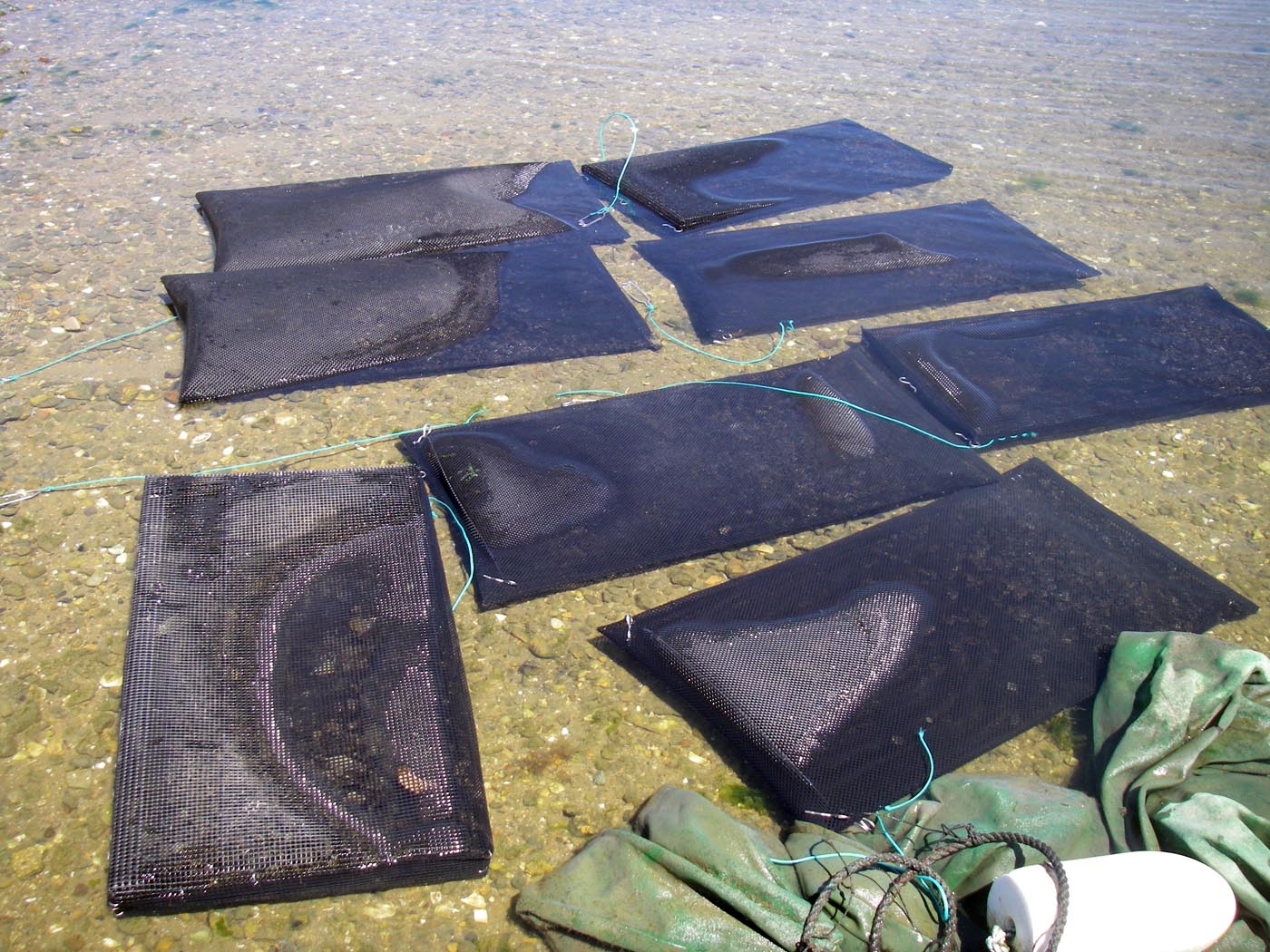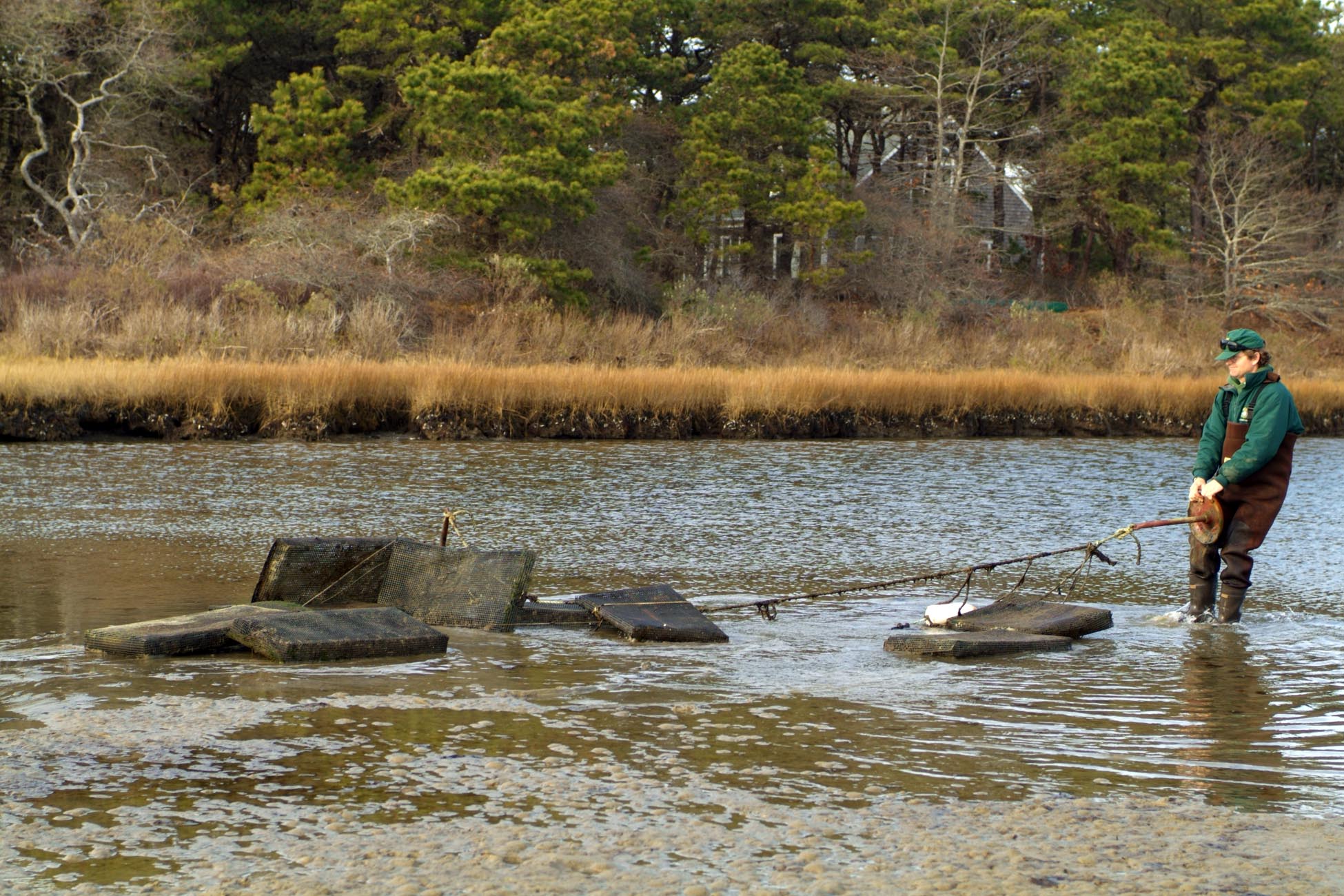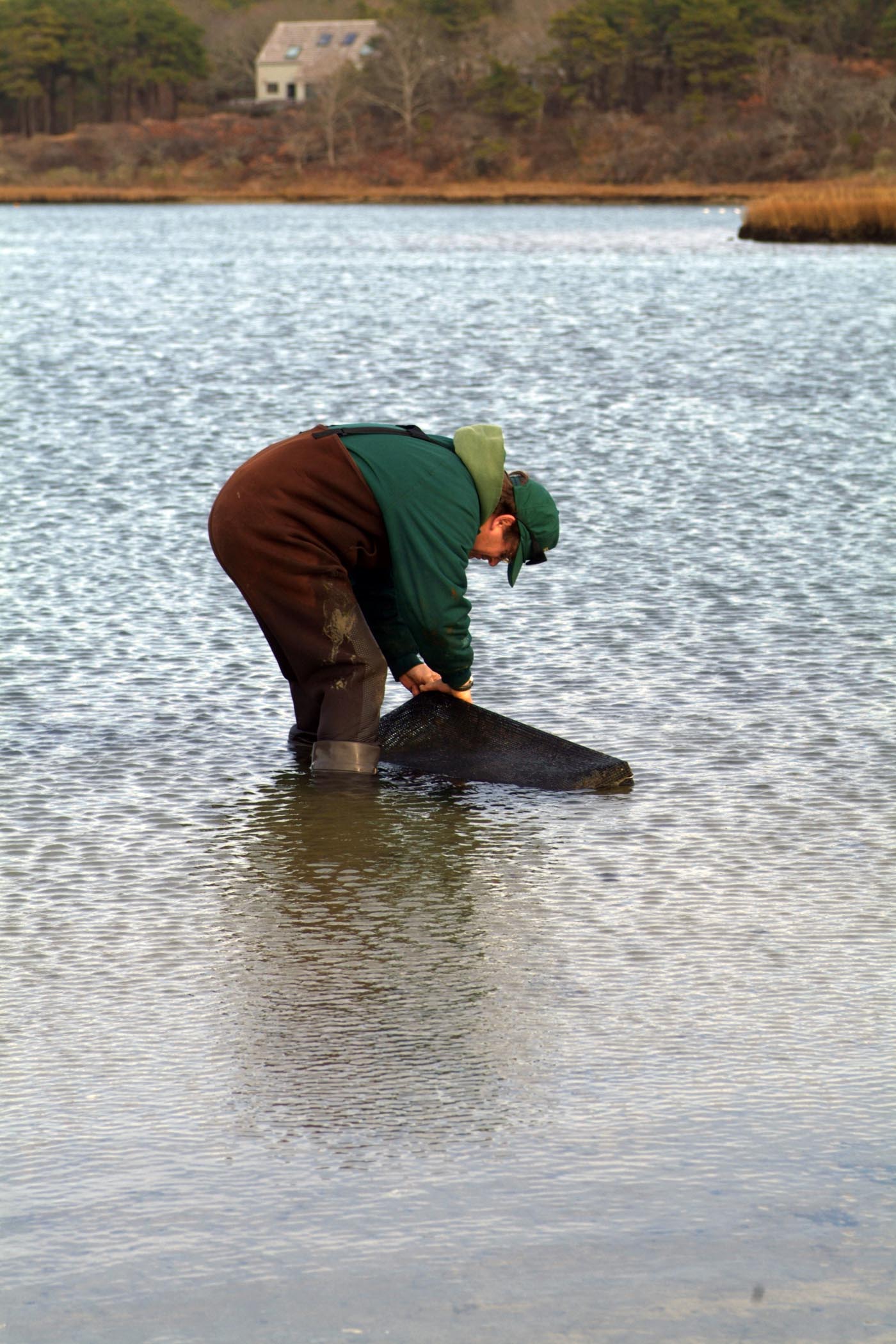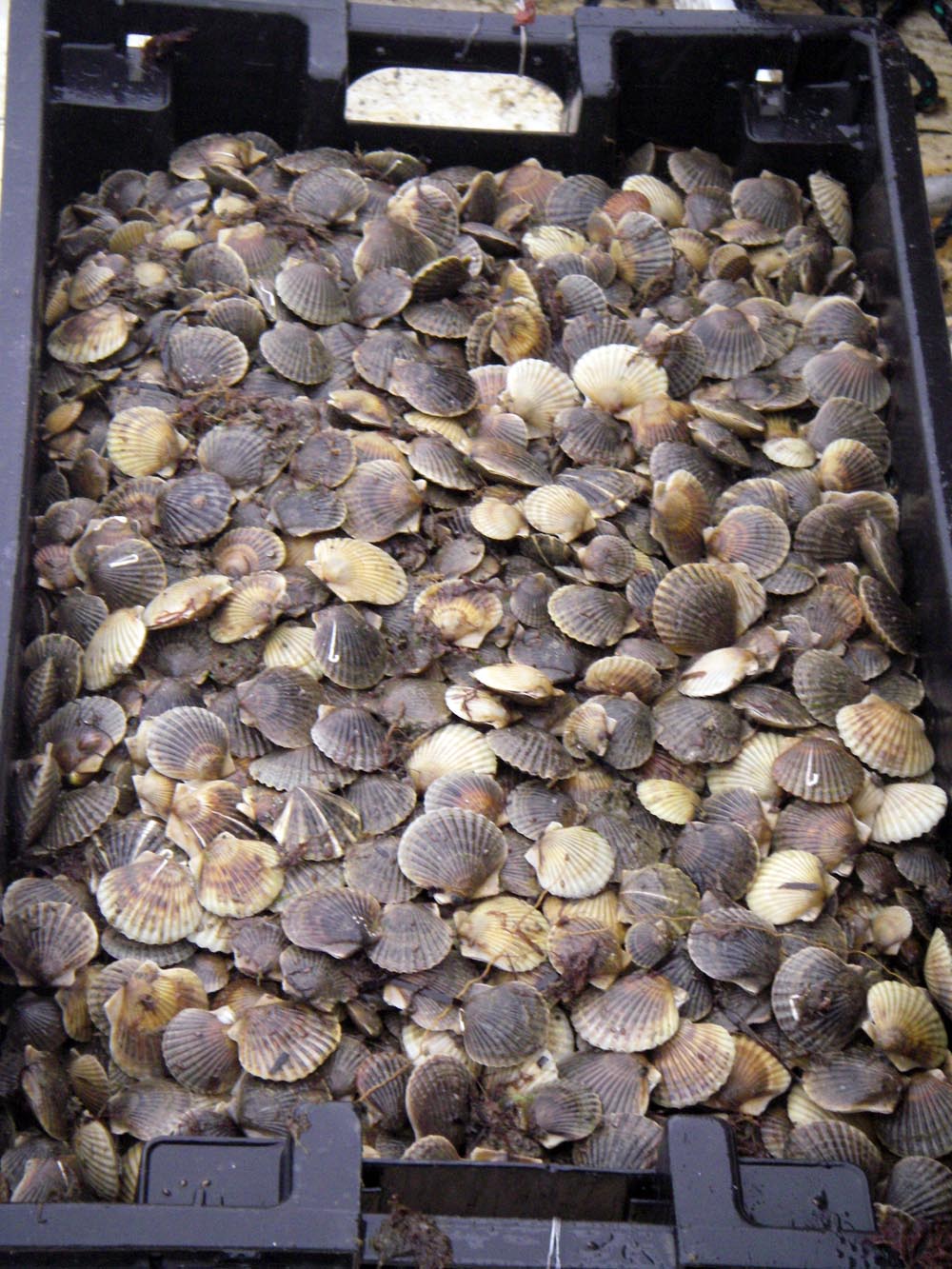For Edgartown shellfishermen, it would be unconscionable to have an autumn and winter without fishing for and harvesting bay scallops. On Cape Cod and Long Island, however, the scallops have all but disappeared.
Warren Gaines, deputy shellfish constable for Edgartown, has spent the past two summers making sure the bay scallop fishery in town remains healthy and viable. His expanding efforts follow a bit of a scare when, for at least a decade, bay scallop landings from Cape Pogue Pond haven’t been up to waterfront expectations.
Using some of the knowledge used by Island oyster farmers, Mr. Gaines has embarked on a town-sanctioned program to restore and nurture the bay scallop fishery in the town’s waters as never before.
The initiative involves taking the juvenile bay scallops provided annually each summer by the Martha’s Vineyard Shellfish Group and holding onto them for months before releasing them into the wild. The project involves a lot of work.
This summer, the Edgartown shellfish department received 2.7 million bay scallops from the shellfish group’s hatchery in Vineyard Haven. But instead of releasing the shellfish immediately in the town’s different coastal ponds, Mr. Gaines took them and put them in floating aquaculture bags. Each of the animals was about the size of a grain of sand.
“We had 300 of these hanging bags,” he said. “They are fine-mesh bags that look like onion bags and offer the animals protection from harmful predators. The bags were put in Cape Pogue, Sengekontacket and Katama Bay.”
Once the little bivalves were about a quarter of an inch in size, they were moved into larger black plastic bags used by oyster fishermen to raise their bivalves. Each black plastic mesh bag, about the size of a pillow, protected them further from hungry and aggressive crabs, starfish and conch. Some were floated but most were tied together and left on the bottom.
The ADPI bags, as they are called in the aquaculture industry, had already been used successfully by the Island’s oyster farmers. The bags are named after a Philadelphia company that makes the plastic mesh.
“This summer we used 180 bags and next summer we may use as many as 400,” Mr. Gaines said.
There were two significant benefits to his work. First, the bags protected the shellfish from predators. Second, the bay scallops inside grew quickly and as much as six times bigger than their wild siblings.
By the end of last summer, when Mr. Gaines started releasing the animals, they were relatively huge. “We grew them out to as big as from 15 to 30 millimeters, which is over an inch in size,” Mr. Gaines said. The results were more than expected.
Paul Bagnall, Edgartown shellfish constable and department head, has high praise for Mr. Gaines’s efforts.
“He has found out what works. He took the bull by the horns,” Mr. Bagnall said.
And the local fishermen also have offered high praise. Edgartown harbor master Charlie Blair, who also is a part-time oyster farmer, said: “Warren did an excellent job and has proved his technology.”
Mr. Blair said he hopes Edgartown will make an even greater commitment to the program in the years ahead.
This part-time project is similar in many respects to what Isaiah Scheffer, Chilmark’s new propagation officer, is doing full-time in Chilmark. Mr. Blair said he hopes Mr. Gaines’s work will continue.
“One guy can only do so much. His success is making sure there is a brood stock for the future,” Mr. Blair said. “He is onto something.”
The question is at what point does the project increase the bay scallop fishery beyond just ensuring that there are parents for shellfish in town waters.
Through the years, Cape Pogue Pond has fairly consistently produced bay scallops from year to year. On the other hand, Sengekontacket Pond hasn’t had a commercially harvestable fishery in years.
Mr. Gaines believes his work is tipping the balance to revitalize the fishery in places that haven’t produced bay scallops, such as Sengekontacket and Katama Bay.
“We feel a little bit like historic preservation. So much of what has built in the town is tied to the scallop season. Just think how important it was,” Mr. Gaines said. “We’d hate to lose that. I’d hate to see the old-time residents not be able to get any.”
The town department is doing other things to ensure the future of bay scallops in Edgartown.
The town is pursuing an aggressive program to control predators by catching crabs and conch that feed on bay scallops.
This summer, the town also used the Martha’s Vineyard Shellfish Group’s Chappaquaddick shellfish nursery as a place to spawn bay scallop larva and released millions of them into the town’s ponds.
Rick Karney, director of the Martha’s Vineyard Shellfish Group, is responsible for raising juvenile shellfish. Each year he raises millions of baby bay scallops, quahaugs and oysters for the participating towns on the Island. Last year alone he produced 13.5 million bay scallops for Vineyard towns.
When Mr. Karney turned over the 2.7 million baby bay scallops to Edgartown, he said he was especially pleased by the extra care that the scallops received from the town’s shellfish constables and personnel.
The larger the animals are when they are released in the wild, the better their survival rate.
“I can produce the seed. But they still need protection and TLC to survive,” Mr. Karney said. “It is great what the towns are doing and it is something the towns should do. From the efficiency standpoint, the more shellfish I can produce the better. If the towns can run the nursery, take the shellfish along, the more valuable our program becomes. We can produce a lot more.”
Bay scallops are a fragile fishery. The animal lives only about 18 months.
“The bay scallop has such a short life span,” Mr. Karney said. “If you lose one year-class, you also lose the brood stock for the next year. If in that second year you had ideal conditions, you could still fail if you don’t have the brood stock. What Warren is doing is ensuring that from year to year there is a natural brood stock out there.”










Comments
Comment policy »